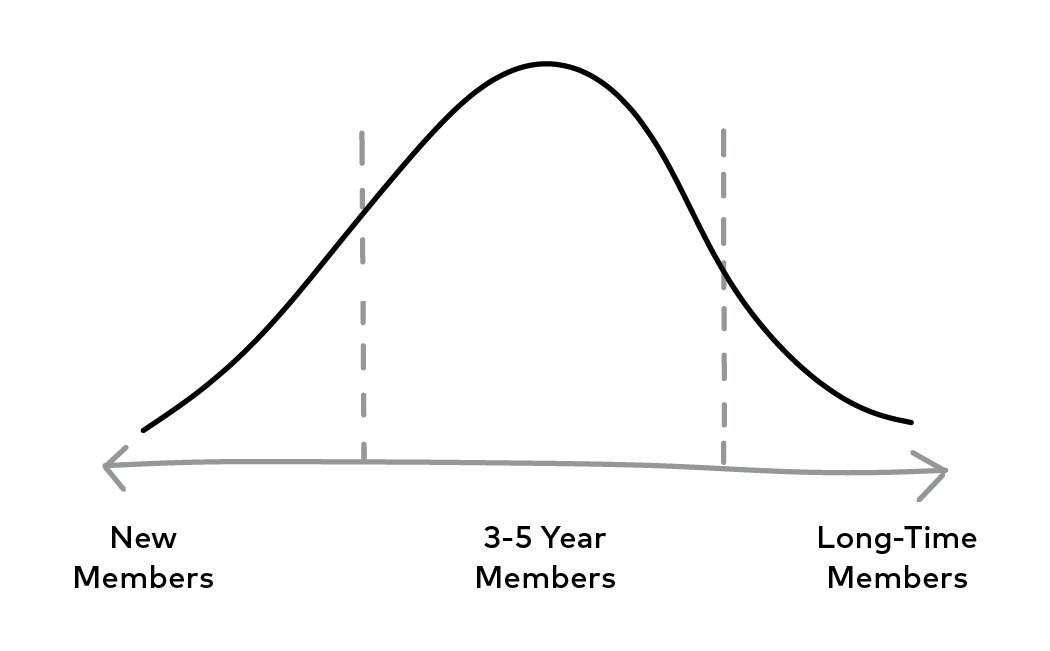The Secret for Winning Back Your Long-Time Members
How do you motivate long-standing members in other countries? Asks Roberta.
This is another excellent question from the audience during one of my recent presentations, and I added it to the ‘Ask Amanda’ series. (You can find the first three articles in the series here, here, and here.)
Roberta’s question is excellent because many associations notice that engagement is like a bell curve. Engagement can be low for both new and long-time members. The bell curve phenomenon seems weird because once a member engages, wouldn’t they stay that way? Unfortunately, in the last stages of engagement, they might drift away.
Chart from Elevating Engagement.
If you notice that long-time members, however you define long-time, whether 5-year, 7-year, 10-year, or another duration, start to lose interest, this article is for you. Do long-time members come to your conference but not to the sessions? Do you notice long-time members log in to the website or open emails less frequently? Are long-time members skipping webinars and other events?
If you are nodding your head rapidly, it could be that your long-time members have different problems to solve—issues that require hard-to-determine solutions, so they need other formats to find those solutions.
When people start their careers, they often solve problems that many have solved before them. They are walking on a well-trodden path. Articles, sessions, and webinars all hold answers to these common problems. But the further we get in our careers, the narrower the well-trodden path, so overgrown with weeds it’s hard to see the dirt. Okay, enough with the analogy because I feel like I’ve got to run out and climb a mountain or something.
The point is, as people progress through their careers, they start encountering thornier problems, problems that have no clear solution, problems that perhaps only a few have experienced. Seemingly unsolvable problems. Long-time members might see trends, technology, or regulations poised to upend the industry or profession. They need solutions and maybe support, but usually, these things can’t be found in a session or article.
So, how do we help long-time members find the solutions and support they need? By offering opportunities to collaborate. Where one person may not have the resources to tackle the problem, many people might! Here are a few formats that offer collaboration:
Special Interest Groups
Special Interest Groups, or SIGS, are like chapters but a bit different. They organize around a topic or problem to solve. SIGS tend to be more successful when they have a tangible outcome goal like producing a whitepaper, industry standard, conference, etc. SIGS can be run virtually, allowing people from all different geographic locations to opt in. Special Interest Groups might stay active for years and continue to be successful by reevaluating the resources they will produce each year.
Labs
Labs might be described as pop-up SIGS. A community organizes around a problem to solve for a finite period. The group finds, brainstorms, and experiments with different solutions. I partnered with Matchbox Virtual Media to run a lab called the Virtual Networking Incubator to determine how to make virtual networking events meaningful, fun, and comfortable.
With labs, it helps to have a great goal that people can rally around. Like SIGS, labs can be run in person or virtually.
Roundtables
Even quicker than labs, roundtables allow people to connect for 15 minutes, an hour, or a day on niche topics that matter most to them. Sometimes, the format is literally round tables with pre-decided topic tent cards on each table and a timer. Or the design can look like Open Space, where participants decide on the topics and run the breakout groups. All formats of roundtables can be run effectively virtually—you can host them on Zoom, or if you can devote a slightly larger budget, check out Circles. This platform helps make breakout groups sing and is especially great for sensitive conversations.
Ready to incorporate collaborative formats into your association? Yay! Because, pssst, collaboration is the secret to re-engaging many of your long-time members.
I hope you’ve been enjoying the ‘Ask Amanda’ series! What question about engagement is top of mind for you? Ask me here.

